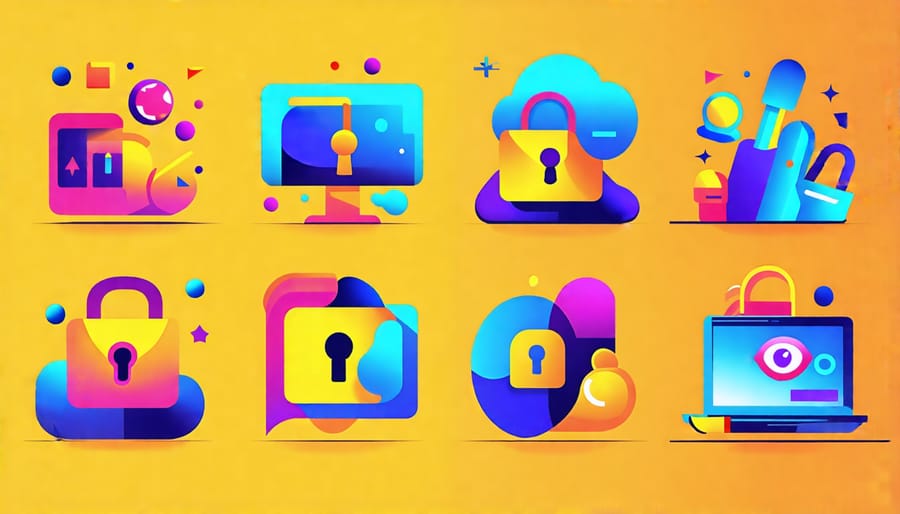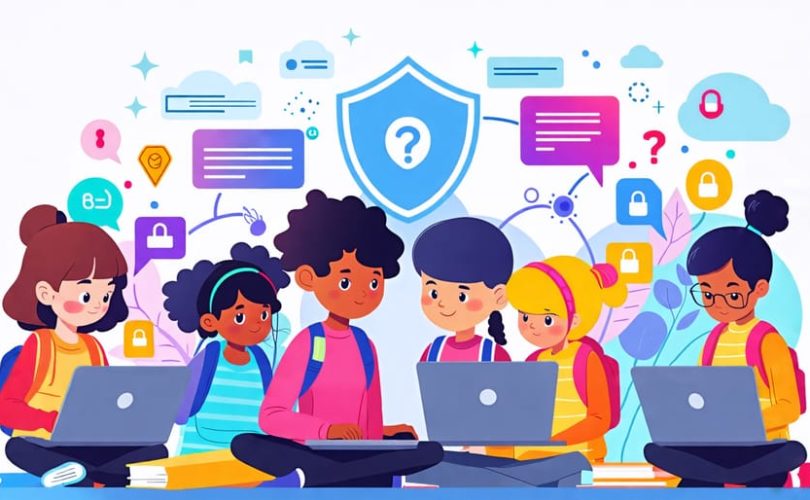Teach elementary students to never share personal information online like their full name, address, phone number or school name. Establish clear rules about what sites kids can visit, who they can interact with, and for how long. Actively monitor children’s online activities, keeping computers in common areas and using parental controls. Foster open communication so kids feel comfortable coming to you with any concerns, questions or if something makes them uncomfortable online. Empower students with the knowledge and confidence to speak up if they encounter cyberbullying, predatory behavior or inappropriate content.
Understanding Online Risks

Recognizing Cyberbullying
Cyberbullying involves using digital devices to harass, threaten, or humiliate someone, often through social media platforms, messaging apps, or online games. Signs your child may be a victim include becoming withdrawn, anxious, or secretive about their online activities; avoiding school or social situations; experiencing a decline in grades; or expressing feelings of helplessness and low self-esteem. Cyberbullying can take a significant emotional toll, leading to depression, self-harm, and even suicidal thoughts. It’s crucial for parents and educators to create a safe, open environment where children feel comfortable sharing their experiences. By maintaining open lines of communication, monitoring online activities, and teaching children to recognize and report cyberbullying, we can help protect their mental health and well-being in the digital age.
Stranger Danger in the Digital Age
In the digital age, online predators pose a serious threat to children’s safety. These individuals may attempt to connect with kids through social media, gaming platforms, or chat rooms, often posing as friendly peers to gain trust. Parents and educators must be vigilant in teaching children to recognize red flags in online interactions.
Some warning signs include an individual asking for personal information, trying to move the conversation to a private platform, or making them feel uncomfortable with inappropriate questions or content. Emphasize to children that they should never share their real name, address, school, or photos with someone they only know online. Encourage open communication and teach them to tell a trusted adult immediately if something doesn’t feel right.
By fostering awareness and open dialogue, we can empower kids to navigate the digital world safely and speak up when they encounter potential online predators or inappropriate behavior online. Consistent education and support are key to protecting our children in the ever-evolving digital landscape.

Essential Cyber Safety Rules
Never Share Personal Information
It’s crucial for kids to understand that personal information should never be shared online. This includes their full name, home address, phone number, school name, and any photos or details that could reveal their identity or location. Explain that there are tricky people on the internet who might try to find them in real life if they share these private details. Encourage children to use screen names that don’t include their real name or age. Remind them to never post about upcoming vacations or share their family’s daily schedule or routines. If anyone online asks for personal information, teach kids to tell a trusted adult right away. By keeping personal details private, children can enjoy the benefits of the internet while staying safe from potential harm.
Check with an Adult
It’s important to always check with a trusted adult, like a parent or teacher, before interacting with someone new online. Even if the person seems friendly, it’s best to get approval first. The same goes for downloading files or filling out forms – these can sometimes contain viruses or trick you into sharing personal information. If you’re ever unsure about something online, don’t hesitate to ask an adult for help. They can guide you on what’s safe and appropriate. Remember, it’s not about not trusting you, but about keeping you protected while you explore the digital world. Open communication with adults is key to staying safe online.
Keep Passwords Secret
Passwords are like the keys to your secret fort – you wouldn’t want just anyone to have them, right? That’s why it’s super important to keep your passwords private and only share them with your parents. Even if your best friend asks for your password, it’s okay to say no. Your passwords are special and should be protected.
When creating a password, try to make it strong like a superhero! Use a mix of uppercase and lowercase letters, numbers, and even special characters like exclamation points or question marks. Avoid using easy-to-guess words like your pet’s name or your favorite color. Instead, create a silly phrase or inside joke that only you would know. And remember, never use the same password for multiple accounts. That way, if one password gets discovered, your other accounts stay safe!
Be Kind Online
It’s important for kids to remember that the same rules for being kind and respectful apply online, just like in real life. Encourage them to treat others the way they’d want to be treated, even if they can’t see the person on the other end of the screen. Remind them that what they say and do online becomes part of their digital footprint that follows them. Teach kids to think before they post, comment, or share. Is it true? Is it kind? Would they say it to someone’s face? Empower them to stand up to cyberbullying if they see it happening. By fostering empathy and responsibility, we can help kids create a more positive online world.
Involving Parents and Teachers
Open Communication
Open communication is essential for keeping children safe online. Make it a priority to have ongoing, age-appropriate conversations with your kids about their digital experiences. Ask open-ended questions about what they enjoy doing online, who they interact with, and if anything ever makes them uncomfortable. Listen without judgment and offer guidance when needed. Share your own experiences to help them understand that you can relate.
Encourage kids to come to you if they encounter anything concerning, such as cyberbullying, inappropriate content, or requests for personal information. Reassure them that you’re there to help and that they won’t get in trouble for speaking up. By fostering a supportive, non-judgmental environment, you create a safe space for your child to discuss their online activities and any potential risks they may face. Regular check-ins help you stay informed about their digital life and address any issues promptly.

Leading by Example
Parents play a crucial role in teaching their children about cyber safety by modeling good online behavior and digital citizenship. Children learn by observing and imitating the adults in their lives, so it’s essential for parents to lead by example when it comes to responsible technology use. This means being mindful of the content you share, the language you use, and the amount of time you spend online. Demonstrate the importance of privacy by being cautious about the personal information you post and the privacy settings you use on social media. Show your kids what respectful online communication looks like by avoiding cyberbullying, trolling, or engaging in hostile interactions. Discuss the websites and apps you use and why you trust them. By embodying the principles of digital literacy and etiquette, you can help your children develop a healthy, balanced relationship with technology and become positive digital citizens.
Empowering Kids to Speak Up
Listening Without Judgment
When your child comes to you with an online issue, it’s crucial to create a safe, non-judgmental space for them to share their concerns. Take a deep breath and remain calm, even if what they share is upsetting or surprising. Avoid overreacting or jumping to conclusions, as this may make your child hesitant to open up in the future. Instead, actively listen to their experience without interrupting or criticizing. Show empathy and validate their feelings, letting them know that it’s brave to speak up and that you’re there to support them. Ask open-ended questions to better understand the situation, but avoid interrogating or blaming your child. Remember, your role is to be a compassionate ally in navigating online challenges together. By fostering open, trusting communication, you empower your child to come to you with any digital dilemmas they may face, knowing they’ll be met with love and understanding.
Helping Kids Develop Resilience
Helping kids build resilience is key to navigating online challenges in a healthy way. Encourage open communication and create a safe space for them to share their experiences without judgment. Teach them to identify and express their emotions, and help them develop coping strategies like deep breathing, positive self-talk, or seeking support from trusted adults. Model resilience by sharing your own experiences and how you overcame difficulties. Encourage a growth mindset, emphasizing that challenges are opportunities to learn and grow. Regularly check in with your child, and if needed, seek guidance from mental health professionals to build resilience. Praise their efforts in handling tough situations and celebrate their successes. By nurturing resilience, you empower your child to face online challenges with confidence and maintain their overall well-being in the digital world.
Conclusion
In conclusion, cyber safety for elementary students is an ongoing conversation that requires active engagement from both parents and educators. By teaching kids essential online safety rules, modeling responsible digital behavior, and fostering open communication, we can empower them to navigate the digital world with confidence and resilience.
Remember, the key takeaways are:
1. Start the cyber safety conversation early and keep it age-appropriate.
2. Establish clear rules and boundaries for internet usage.
3. Encourage kids to speak up if they encounter anything uncomfortable online.
4. Monitor children’s online activities while respecting their privacy.
5. Educate yourself about the latest trends, apps, and potential risks.
6. Model responsible digital citizenship in your own online behavior.
Building a foundation of cyber safety awareness in elementary school sets the stage for responsible and safe internet usage as children grow older. It’s crucial to maintain an ongoing dialogue, adapt to new technologies, and provide a supportive environment where kids feel comfortable discussing their online experiences.
For parents and teachers seeking additional resources, there are many reputable organizations and websites dedicated to promoting online safety for children. Common Sense Media offers age-based media reviews and guidance, while NetSmartz provides interactive resources for kids, parents, and educators. The National Cyber Security Alliance also offers valuable tips and tools for staying safe online.
By working together, parents and educators can create a safer digital world for our children. Let’s continue to prioritize cyber safety education and empower our kids to become responsible digital citizens. With the right knowledge, skills, and support, they can unlock the incredible potential of technology while staying safe and secure online.







